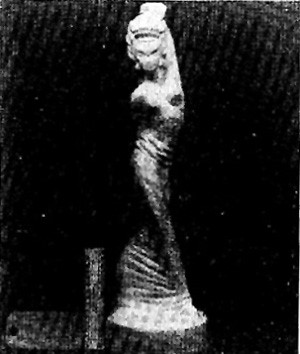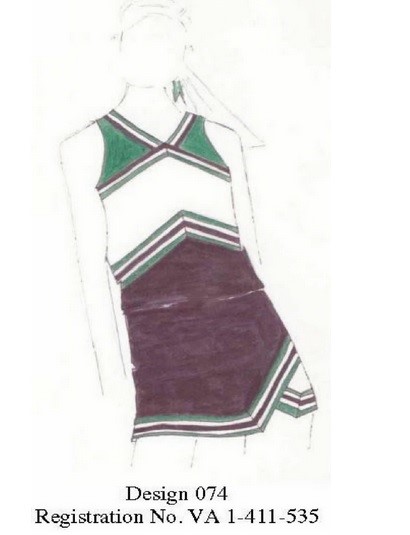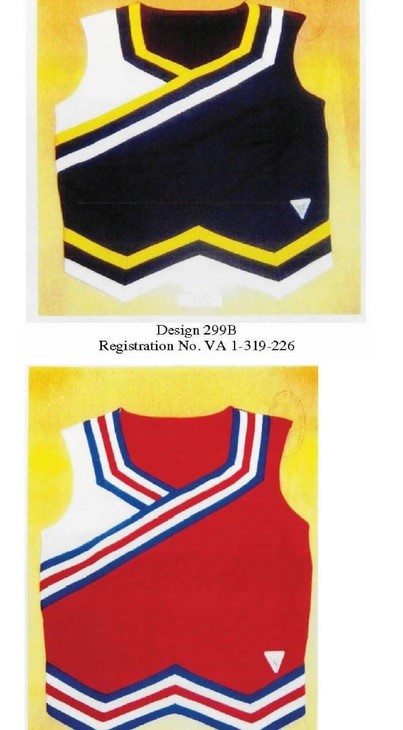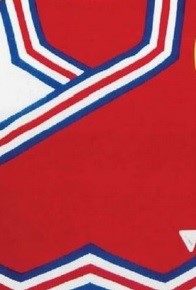It’s not often that the Supreme Court of the United States gets involved in a dispute over a dress, but that’s the case in Star Athletica LLC v. Varsity Brands. 1 This blog has reported on this dispute before, 2 involving what parts, if any, of a cheerleader’s outfit are protected by copyright.
In a 6-2 ruling last week, the Supreme Court ruled that certain stylistic elements which make up the dress, as apart from the dress itself, are capable of copyright protection. Notice that the word “elements” is used, because that is in fact the ruling. The Court is not ruling here that the cheerleader outfit is, in itself, copyrightable. It is instead ruling that certain elements, when separated conceptually from the dress, can be copyrightable. So, you can ignore the headlines such as this one from CNN/Money that say “Give Me a ©! Supreme Court rules cheerleader uniforms can be copyrighted,” 3 for this is not the case. Special recognition is also due CNN/Money for nicking this blog’s year and a half old headline of “Gimme a ©,” but I digress.
Here is the Court’s actual ruling:
“We hold that a feature incorporated into the design of a useful article is eligible for copyright protection only if the feature (1) can be perceived as a two- or three-dimensional work of art separate from the useful article and (2) would qualify as a protectable pictorial, graphic, or sculptural work—either on its own or fixed in some other tangible medium of expression—if it were imagined separately from the useful article into which it is incorporated.” 4
Where the dispute arises is that copyright does not protect functional aspects of any item, it only protects the artistic elements. The definition of “pictorial graphic and sculptural works” makes this plain:
“Such works shall include works of artistic craftsmanship insofar as their form but not their mechanical or utilitarian aspects are concerned; the design of a useful article, as defined in this section, shall be considered a pictorial, graphic, or sculptural work only if, and only to the extent that, such design incorporates pictorial, graphic, or sculptural features that can be identified separately from, and are capable of existing independently of, the utilitarian aspects of the article.” 5
This sounds a lot easier than it actually is. The Supreme Court previously visited this concept in Mazer v. Stein 6 way back when in 1954. At issue was a lamp base seen here:

The upshot of the ruling was yes, it’s a lamp base, which has to perform certain functions. In short, it has to stand upright with sufficient support so the lamp and lampshade will not fall over. However, if you remove the fact that its primary function is that it’s a lamp base, does it function as a sculpture? Standing alone, you would have to agree that it does. A very kitschy sculpture, but the copyright act has never been concerned with artistic worth or merit.
What brings us to the present case is that the cheerleader uniform has functionality highly interwoven into its entire purpose. In order to be a proper cheerleader uniform is has to allow the wearer the necessary freedom of movement to enable performance of the cheerleading activity, which frequently involves gymnastic moves, and be bright and colorful enough to draw attention to the wearer. Put more simply, “form follows function.”
Here is one of the drawings that accompanied the Plaintiff’s copyright registrations:

If you were to go back and look at the Mazer sculpture, you would not immediately conclude that it was a lamp base. But looking at the Plaintiff’s drawing, you would immediately conclude “that’s a cheerleader outfit.”
Which is the point of the dissent:
“By way of contrast, Van Gogh’s painting of a pair of old shoes, though beautifully executed and copyrightable as a painting, would not qualify for a shoe design copyright.” 7
And further,
“Consider designs 074, 078, and 0815. They certainly look like cheerleader uniforms. That is to say, they look like pictures of cheerleader uniforms, just like Van Gogh’s old shoes look like shoes. I do not see how one could see them otherwise.” 8
Yet as the majority opinion states:
“This is not a bar to copyright. Just as two-dimensional fine art corresponds to the shape of the canvas on which it is painted, two-dimensional applied art correlates to the contours of the article on which it is applied. A fresco painted on a wall, ceiling panel, or dome would not lose copyright protection, for example, simply because it was designed to track the dimensions of the surface on which it was painted. Or consider, for example, a design etched or painted on the surface of a guitar. If that entire design is imaginatively removed from the guitar’s surface and placed on an album cover, it would still resemble the shape of a guitar. But the image on the cover does not ‘replicate’ the guitar as a useful article. Rather, the design is a two-dimensional work of art that corresponds to the shape of the useful article to which it was applied.” 9
Let’s take these two other photographs that accompanied the Plaintiff’s registrations:

If we were to take these and extend the image so that it no longer bears the shape of a cheerleader top, and paint them on a canvas, would this not qualify as a “pictorial, graphic or sculptural work?” Let’s see if this hypothetical holds up using the magic of Microsoft Paint.

I think the answer to this question is unequivocally “yes.” Especially if you’ve ever been to the Museum of Modern Art In New York City.
This is the point of Justice Ginsberg’s concurring opinion.
“Unlike the majority, I would not take up in this case the separability test appropriate under 17 U.S.C. § 101. Consideration of that test is unwarranted because the designs at issue are not designs of useful articles. Instead, the designs are themselves copyrightable pictorial or graphic works reproduced on useful articles… The designs here in controversy are standalone pictorial and graphic works that respondents Varsity Brands, Inc., et al. (Varsity) reproduce on cheerleading uniforms. Varsity’s designs first appeared as pictorial and graphic works that Varsity’s design team sketched on paper. Varsity then sought copyright protection for those two-dimensional designs, not for cheerleading costumes; its registration statements claimed ‘2–Dimensional artwork’ and ‘fabric design (artwork).’” 10
Yes, but to a certain extent, the lines and shapes are rudimentary and fairly commonplace, and not exactly striking examples of originality. The majority states as much in the very first footnote:
“We do not today hold that the surface decorations are copyrightable. We express no opinion on whether these works are sufficiently original to qualify for copyright protection.” 11
Therefore, I would expect that the doctrine of independent creation will come into play (so proof of access is highly relevant) and a high degree of substantial similarity should be required. In other words, the “knock-off” would have to be almost an exact copy in order to be infringing. This is not exactly the sweeping victory for the fashion industry that some have touted.
The story may be different for the 3-D printing industry, where the very basis of its business model is the ability to make 100% perfect copies of existing objects. To the extent that the object being copied has artistic, and non-essential elements, those may be brought to bear in a suit for copyright infringement.
The pattern of a fabric design would seem to be a sure bet for copyright protection. After that, who knows? Is the placement of an ornamental ribbon at a certain spot on a blouse enough to qualify for copyright? A series of fabric roses around the waistline of a dress? I expect the same questions that bedevil architectural works cases would crop up in fashion cases.
After all, in the words of Justice Breyer:
“The clothes on the hanger do nothing. The clothes on the woman do everything. And that is, I think, what fashion is about.” 12
Notes:
- 2017 WL 1066261 ↩
- Gimme a “©”! A Court’s Conclusion on Cheerleader Clothing Copyright ↩
- Give Me a ©! Supreme Court rules cheerleader uniforms can be copyrighted ↩
- 2017 WL 1066261 at 4 ↩
- 17 USC 101 ↩
- 347 US 214 (1954) ↩
- 2017 WL 1066261 at 17 ↩
- 2017 WL 1066261 at 20 ↩
- 2017 WL 1066261 at 10 ↩
- 2017 WL 1066261 at 14 ↩
- 2017 WL 1066261 at footnote 1 ↩
- Copyright (and Fashion) Advice from the US Supreme Court ↩